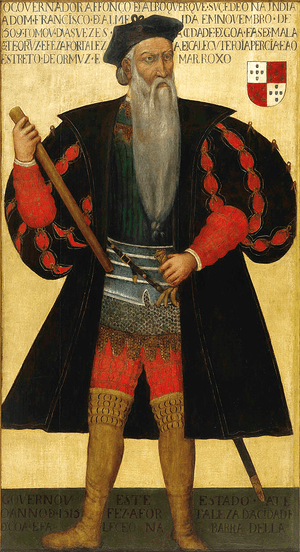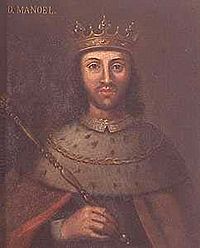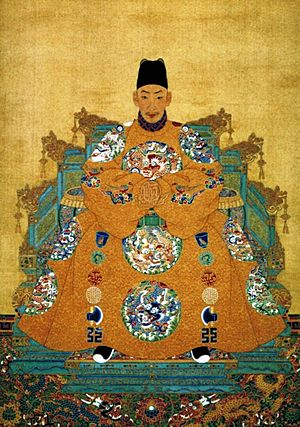Fernão Pires de Andrade facts for kids
Quick facts for kids
Fernão Pires de Andrade
|
|
|---|---|
| Died | 1552 |
| Nationality | Portuguese |
| Occupation | Merchant, pharmacist and diplomat |
| Known for | Diplomatic encounter with the Chinese Ming dynasty |
Captain Fernão Pires de Andrade (died 1552) was a Portuguese merchant, pharmacist, and official diplomat. He worked for the famous Portuguese explorer and governor, Afonso de Albuquerque.
In 1517, Fernão Pires de Andrade made an important trip to Ming China. This was after earlier visits by Jorge Álvares in 1513 and Rafael Perestrello in 1516. His visit was the first time Europeans had direct trade and diplomatic talks with China in a long time. Before this, people like Marco Polo had visited, but contact had stopped when the Yuan dynasty fell.
Andrade's trip started well, and a Portuguese group even reached Beijing. However, things quickly went wrong. His brother, Simão, caused many problems that angered the Chinese. There were also false stories that the Portuguese ate their slaves. Plus, the Chinese learned that the Portuguese had conquered Malacca, which was a loyal state that paid tribute to the Ming Emperor. Because of these issues, the Chinese formed a very negative opinion of the Portuguese.
It took a long time for trade and good relations between Portugal and the Ming dynasty to start again. This finally happened in the late 1540s, and in 1557, the Portuguese were allowed to set up a base in Macau.
The Chinese called Fernão Pires de Andrade and other Portuguese "Folangji" (佛郎機). This name came from "Franks," which was a general term Muslims used for Europeans since the Crusades. The Chinese first heard this term from Muslim guides and used it for the Portuguese before they met Europeans directly.
Contents
Voyages Abroad
India, Sumatra, and Malacca

In 1511, Fernão Pires de Andrade commanded a ship in the fleet of Afonso de Albuquerque. They sailed from Cochin, India, to conquer the Malacca Sultanate. The Portuguese historian João de Barros wrote about a big storm that hit Albuquerque's fleet. A ship commanded by Simão Martinho sank, but Fernão rescued his entire crew.
To make up for the lost ship, the Portuguese captured five ships from Gujarat. These ships were sailing between Malacca and Sumatra. Albuquerque's small fleet then fought a "junk" ship belonging to the Malaccan "Moors." This battle near an island between Lumut and Belawan lasted two days. The enemy crew even tried to set their own ship on fire to burn Albuquerque's ships. They used ramming tactics and fired cannons at close range.
Even though the enemy ship surrendered, the Portuguese admired its bravery so much they called it O Bravo (The Brave Junk). Fernão Pires convinced Albuquerque to spare the crew. He argued that they were simply unaware of who they were fighting. Albuquerque agreed to let them go.
João de Barros also wrote about Albuquerque's trips to Sumatra. He noted that the Chinese were the first to control trade between Sumatra and India. He also mentioned that Chinese people lived in Sumatra. Barros said that while Fernão Pires was loading spices in Pacem (a kingdom in Sumatra), two kings were killed and replaced. This didn't cause much trouble there. The locals believed a ruler didn't have a divine right to rule if a royal family member could kill him. Historian Mark Dion noted that Fernão wrote the same story. He added that only a Muslim could replace a ruler in that society.
First Contact with China
After the conquest of Malacca in 1511, the Portuguese controlled the European spice trade. They also traded a lot with Chinese merchants. When the Portuguese first arrived in Malacca in 1509, local Chinese, Javanese, and Tamil merchants supported them.
Albuquerque sent Jorge Álvares to explore northwards. In 1513, his expedition sailed along the coast of Guangdong. He even raised a flag on "Tuen Mun island." Later that year, Rafael Perestrello followed up on this mission. He traded with Chinese merchants in Canton in 1516. Perestrello gave an exciting report to other Portuguese about the profitable trade in China. This made Andrade hurry his mission to China, even though he was still in Malacca.
Mission of Manuel I to China
Choosing the Ambassadors

King Manuel I approved a trade mission in 1517. Fernão Pires de Andrade set sail on June 17, 1517, with seven merchant ships armed with cannons. He also had a Muslim interpreter. Andrade had been chosen for this mission in Lisbon back in 1515. As a pharmacist, he was to study the medicines used in East Asia. This was to benefit Portugal and Europe.
Giovanni da Empoli, a merchant from Florentine, was also chosen. He was the chief commercial agent. However, Giovanni died in China on October 15, 1517, when his ship accidentally caught fire. Tomé Pires, a royal apothecary, was chosen as the main ambassador. He had also traveled to India and written an important book about Asian trade in 1515.
First Contact
The mission lost a ship in the Strait of Malacca, but they still reached the Pearl River estuary on August 15. They had eight ships. They talked with Chinese officials about trading silk and porcelain at Canton. The Chinese naval commander of Nantou (near the Pearl River mouth) held Andrade's fleet for a month. Andrade waited for permission to sail upriver to Canton. When Andrade threatened to sail without permission, the commander finally let him pass. He even gave them pilots to help with the journey.
When the ships reached Canton, they fired their cannons. The Portuguese thought this was a friendly salute, like Chinese merchants had done in Malacca. But this alarmed the Chinese residents and officials. Chinese officials became even more careful with the Portuguese. This was because the deposed King of Malacca had been a loyal tributary to the Ming court. The Portuguese explained that they helped Chinese merchants in Malacca by removing the king who oppressed them. But to the Canton officials, this made the Portuguese seem even more suspicious. Private Chinese overseas trade was banned under the "hai jin" laws. Only the Chinese government could trade with foreign countries.

Local Canton officials watched the Portuguese ships closely. But when the provincial authorities arrived, they welcomed the Portuguese warmly. They gave them comfortable places to stay and brought their trade goods ashore. The Chinese became suspicious again when Andrade sent a ship along the Fujian coast to look for more trade. They thought he might be a spy. However, Andrade made a good impression when he said that any local person harmed by a Portuguese should come to him for help. Besides exploring Fujian, Andrade sent one of his captains, Jorge de Mascarenhas, to explore the Ryukyu Islands. He had heard about their beauty while in Malacca.
Andrade's Brother and Spoiled Relations
Simão de Andrade, Fernão Pires's brother, sailed from Malacca to China in August 1519. He had a small crew on three junks. Simão immediately made a bad impression on the Chinese. He built a fort in the middle of Tuen Mun, an island where all foreigners were supposed to trade. Soon after, Simão publicly executed a Portuguese man. He also stopped other foreigners, mostly Siamese and other Southeast Asians, from trading on the island. This drew even more attention to him. When a Chinese official visited the island to show Ming authority, Simão became aggressive and hit him, knocking off his hat.
The biggest offense to the Chinese was the rumor that the Portuguese were kidnapping children to eat them. In reality, Simão had given the Portuguese a bad name by buying young Chinese children. He offered large sums of money for them. Some of these children, from wealthy Chinese families, were later found by Portuguese officials in Diu, India. Even though Simão stayed until September 1520, there were no official reports of his abuses. However, rumors of his behavior, which became linked to all Portuguese, likely reached Beijing. This would soon lead the Chinese to condemn the Portuguese.
Even after leaving Canton, Simão de Andrade landed at Xiamen and Ningbo, setting up settlements there. Simão kept breaking local Chinese laws in Ningbo. In 1545, when his men felt cheated in a trade deal, Simão sent armed men into the town. They robbed it and took local women and girls captive. The angry locals fought back and killed many Portuguese under Simão. A similar event happened later when Coelho de Sousa took over a wealthy foreign resident's house in Jinzhou, Fujian. This led authorities to cut off supplies to the Portuguese. The Portuguese then attacked a nearby village for supplies. In response, Chinese authorities destroyed thirteen of their ships. Thirty Portuguese survivors fled to the Portuguese settlement at Macau in 1549.
End of the Mission
The Portuguese embassy, including Tomé Pires and Fernão Pires de Andrade, left Canton in January 1520. They traveled north. In May 1520, the embassy reached Nanjing, where the Zhengde Emperor was visiting. The emperor quickly met with the Portuguese. However, further talks were to happen when the emperor returned to Beijing. So, the Portuguese embassy was sent to Beijing to wait.

Portuguese sources say that the Portuguese were called to bow before a wall of the Forbidden City twice a month. They hoped to meet the emperor again. From Beijing, the Portuguese heard that the emperor reached Tongzhou in January 1521. He had the rebel Prince of Ning executed there. The Portuguese embassy also learned that ambassadors from the exiled King of Malacca had come to Beijing. They asked the Chinese emperor for help to remove the Portuguese and put their king back in power.
The Portuguese also knew that two officials in the Censorate, Qiu Daolong and He Ao, had written to the emperor. They condemned the Portuguese conquest of Malacca and said the embassy should be rejected. There were also reports from Canton officials to Beijing. They said the Portuguese were troublesome foreigners who wanted to build their own trading post.
The Zhengde Emperor died on April 19, 1521. Mourning ceremonies began, canceling all other events, including meetings with foreign groups. The new Grand Secretary, Yang Tinghe, soon worked against the powerful eunuchs at court. The eunuchs had become very powerful under the Zhengde Emperor. Ming officials believed that only foreign states listed at the start of the dynasty should be allowed at court. But the eunuchs wanted to expand trade with new countries. The Zhengde Emperor, who was curious about foreign peoples, allowed these desires. However, after his death, Yang Tinghe challenged the eunuchs' power. He announced the rejection of the Portuguese embassy the day after the emperor's death. The embassy was forced to leave and returned to Canton in September.
Open Hostility to Reopening of Relations
Earlier, in April and May 1521, five Portuguese ships docked at Tuen Mun to trade. But officials came to the region to announce the emperor's death and ordered them to leave. The Portuguese refused. So, the Chinese sent a naval group to drive them out. They sank one ship, killed many, and took the rest as prisoners (First Battle of Tamao). Two more Portuguese ships arrived in June. Chinese ships attacked them, but the Portuguese fought them off. Three more Portuguese ships barely fought off another attack in September. This was the same month Fernão Pires de Andrade and Tomé Pires arrived back in Canton. Ming authorities would not let Fernão and Pires see the prisoners from the sea battles. They also made lists of their goods and the goods captured from the Portuguese ships.
In August 1522, Martim Afonso de Melo Coutinho arrived at Tuen Mun with three ships. He didn't know about the conflict. He expected to meet Chinese officials to get permission for a Portuguese trade base in China. Two of his ships were captured in a surprise Chinese attack. The survivors escaped back to Portugal on the third ship (Second Battle of Tamao). These battles brought the first breech-loading culverins (a type of cannon) into China. The philosopher Wang Yangming even mentioned them in 1519.
The prisoners from these sea battles were executed in 1523. They were charged with "robbery on the high seas" and other false accusations. Tomé Pires was kept prisoner. He was forced to write letters to the King of Portugal, the Viceroy of Portuguese India, and the Governor of Malacca. These letters carried the new Ming emperor's message. The emperor demanded that the Portuguese leave Malacca and give it back to its rightful king.
Some stories say Fernão Pires de Andrade died while imprisoned. Others say he was one of those executed. This happened after a court decided his embassy was not legitimate due to negative reports about the Portuguese. These reports included actions by people like Fernão Pires's brother, Simão. Tomé Pires died as a prisoner in China. It's not clear if he died in 1524 or 1540. Two survivors of this embassy were still alive around 1536. They sent letters to Malacca and Goa with plans for the Portuguese to capture Canton by force. Other survivors settled in Lampaco (Lampa) in Guangdong. A trade post existed there for several decades. In 1537, records show the Portuguese had three warehouses at Lampa, Shangchuan Island, and Macau. They were first allowed there with the excuse of drying their goods during a storm.
Despite the early conflicts, good relations between the Portuguese and Chinese started again in 1549. This followed an event where the Portuguese helped Ming authorities get rid of coastal pirates. Portuguese trade missions to Shangchuan Island then became annual. In 1554, Leonel de Sousa, a later Governor of Macau, made a positive agreement with Cantonese authorities. Finally, in 1557, the Ming court allowed a permanent and official Portuguese trade base at Macau.
Fernão Pires de Andrade and his Portuguese friends were the first to open China to the West. But another important diplomatic mission to Beijing didn't happen until 1598. That's when an Italian Jesuit, Matteo Ricci (1552–1610), traveled there.
See also
 In Spanish: Fernão Pires de Andrade para niños
In Spanish: Fernão Pires de Andrade para niños


